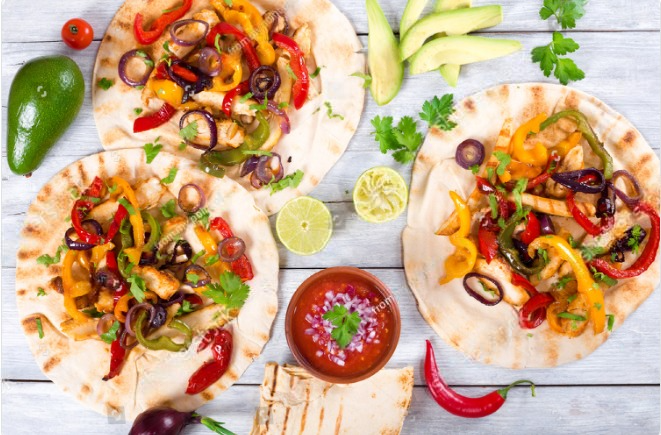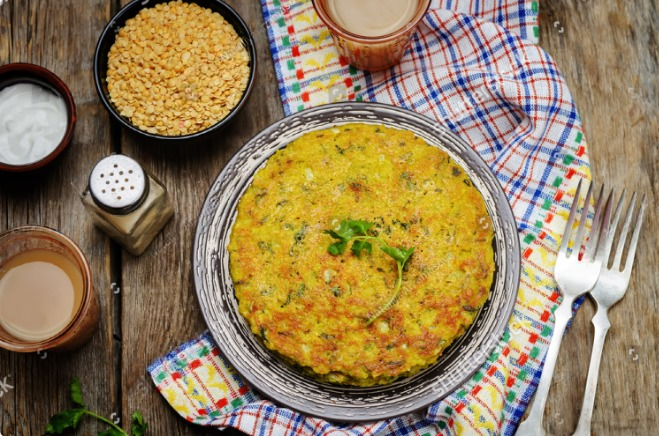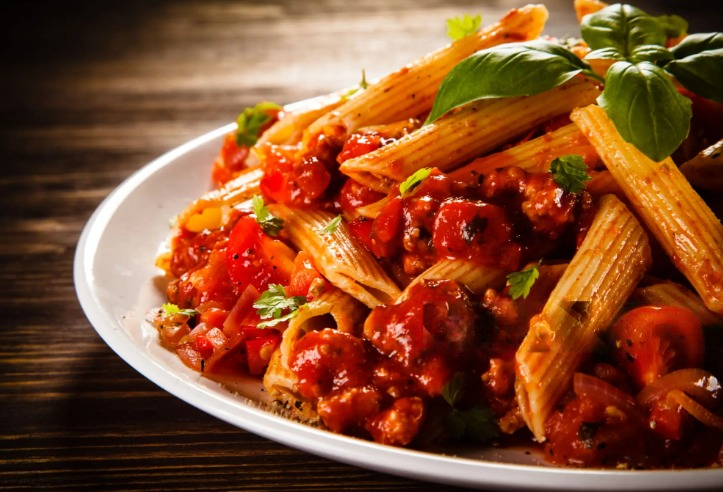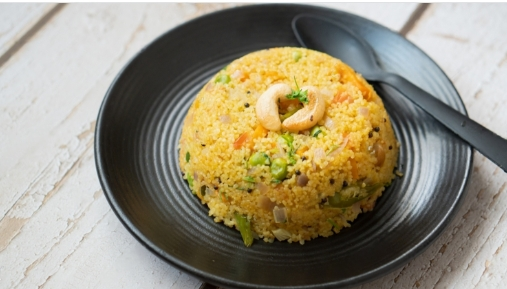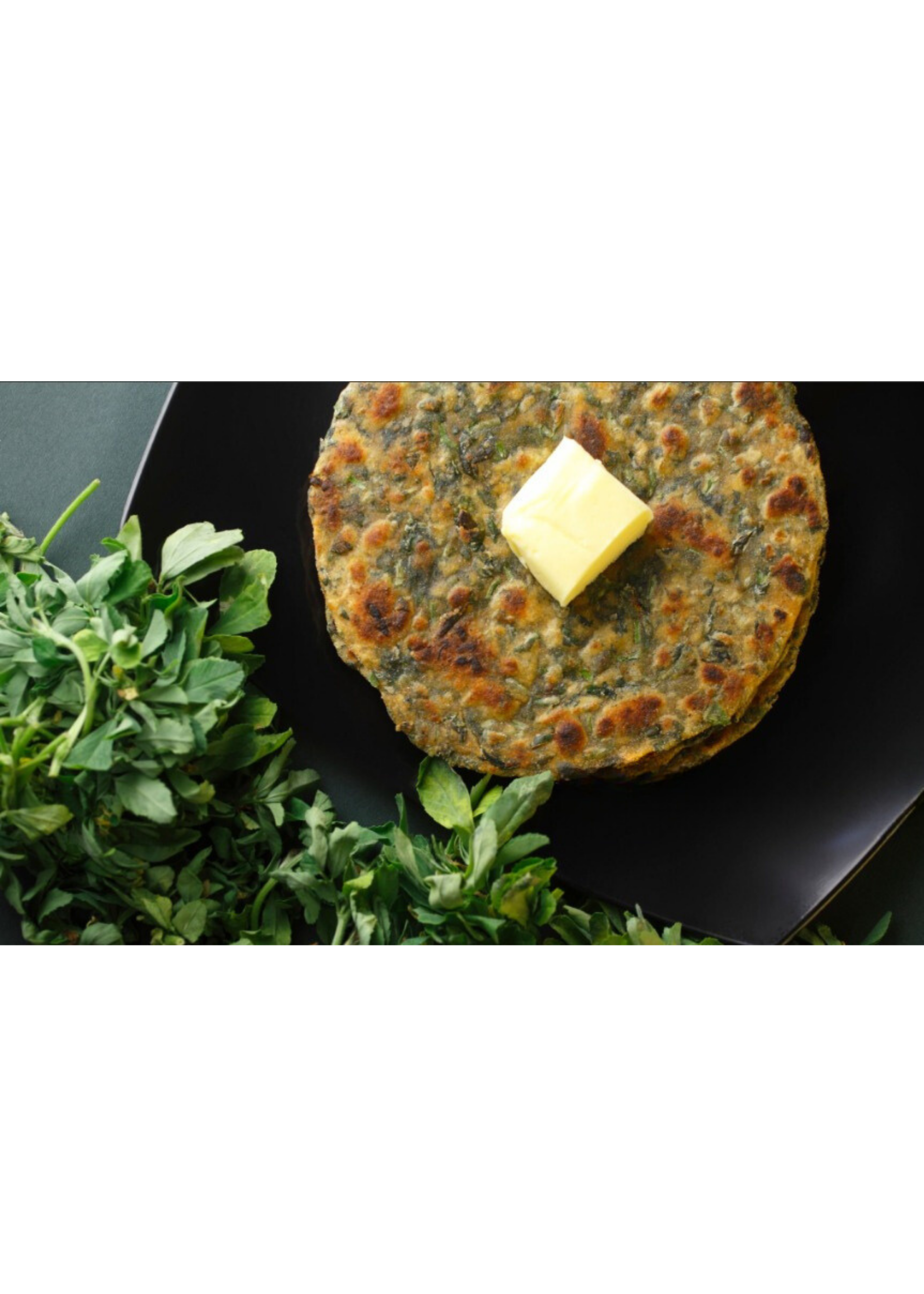About Grilled Vegetable Wraps are a PCOS-friendly meal option that pack a nutrient-dense punch. The combination of fiber-rich whole-grain tortillas, antioxidant-rich grilled vegetables, and optional protein sources creates a balanced and blood sugar-friendly dish that can help manage the symptoms of poly cystic ovary syndrome. Ingredients: – 4 whole-wheat tortillas or wraps – 1 zucchini, sliced into thin strips – 1 bell pepper, sliced into strips – 1 eggplant, sliced into thin rounds – 1 red onion, sliced – 2 tbsp olive oil – 1 tsp dried oregano – 1 tsp garlic powder – Salt and pepper to taste – 2 cups baby spinach or arugula – 1/4 cup crumbled feta cheese (optional) Instructions: Preheat your grill or grill pan to medium-high heat. In a large bowl, toss the sliced zucchini, bell pepper, eggplant, and onion with the olive oil, dried oregano, garlic powder, salt, and pepper until well coated. Grill the vegetables for 2-3 minutes per side, or until they’re tender and have grill marks. Remove the grilled vegetables from the heat and let them cool slightly. Lay the whole-wheat tortillas or wraps on a flat surface. Divide the grilled vegetables evenly among the tortillas, placing them in the center. Top each wrap with a handful of baby spinach or arugula. If using, sprinkle the crumbled feta cheese over the vegetables. Fold the bottom edge of the tortilla over the filling, then fold in the sides and roll up tightly to create a wrap. Serve the grilled vegetable wraps immediately. Nutritional Value (per serving): – Calories: 300 – Protein: 10g – Carbohydrates: 38g – Fiber: 7g – Fat: 13g – Sodium: 450mg Benefits of Grilled Vegetable Wraps for PCOS: Nutrient-Dense: The variety of grilled vegetables, such as zucchini, bell pepper, and eggplant, provide a wide range of essential vitamins, minerals, and antioxidants that are beneficial for PCOS management. High in Fiber: The whole-wheat tortilla and the vegetables contribute a significant amount of fiber, which can help with digestion, promote feelings of fullness, and support healthy blood sugar regulation. Low Glycemic Index: The complex carbohydrates in the whole-wheat tortilla have a low glycemic index, which helps prevent rapid spikes in blood sugar levels. Anti-Inflammatory Properties: The garlic and oregano in the recipe have anti-inflammatory properties that can help manage PCOS-related inflammation. Versatile and Customizable: You can easily customize the fillings of vegetable wrap to include your favorite PCOS-friendly vegetables and adjust the recipe to suit your taste preferences. FAQs: 1.Can I use different types of wraps or tortillas? – Yes, you can use other whole-grain or gluten-free wraps or tortillas, depending on your dietary needs. 2.Can I add a protein source to the wrap? – Absolutely! You can add grilled chicken, tofu, or chickpeas to make the wrap more filling and balanced. 3.Can I prepare the grilled vegetables in advance? – Yes, you can grill the vegetables in advance for vegetable wrap and store them in the refrigerator for up to 3 days. This can save time when assembling the wraps. 4.Is this recipe suitable for those with nut allergies? – Yes, this vegetable wrap recipe does not contain any nuts, making it a safe option for individuals with nut allergies. Written By:-Amisha
Category: PCOS Recipes
PCOS friendly Moong Dal Cheela Recipe
About Moong Dal Cheela is a PCOS-friendly Indian pancake made with a batter of mixed lentils. The high-protein and fiber-rich lentil mix, along with the addition of anti-inflammatory spices, make this dish a nutritious option for managing polycystic ovary syndrome. Ingredients: – 1 cup mixed lentils (moong, masoor, urad) – 1 cup water – 1/2 tsp cumin seeds – 1/2 tsp mustard seeds – 1 green chili, finely chopped (optional) – 1 tsp grated ginger – 1/4 cup chopped onion – 2 tbsp chopped cilantro – Salt to taste – Ghee or oil for cooking Instructions: Soak the mixed lentils in water for at least 2-3 hours or overnight. Drain the lentils and grind them into a smooth batter using a blender or food processor. Add water as needed to achieve a pourable consistency. In a small pan, heat a teaspoon of ghee or oil over medium heat. Add the cumin seeds and mustard seeds, and let them crackle. Add the chopped green chili (if using), grated ginger, and chopped onion. Sauté for 2-3 minutes until the onion is translucent. Add the lentil batter to the pan and mix well. Season with salt. Spread the batter evenly in the pan to form a thin pancake or cheela. Cook for 2-3 minutes on each side until golden brown. Remove the cooked cheela from the pan and garnish with chopped cilantro. Serve hot, optionally with a side of low-GI chutneys or curries. Nutritional Value (per serving): – Calories: 120 – Protein: 8g – Carbohydrates: 15g – Fiber: 5g – Fat: 4g – Sodium: 150mg Benefits of Moong Dal Cheela for PCOS: High in Protein: The combination of mixed lentils provides a significant amount of protein, which is essential for maintaining muscle mass and regulating blood sugar levels. Rich in Fiber: The lentils and onions in the cheela contribute a good amount of fiber, which can help with digestion, promote feelings of fullness, and support healthy blood sugar management. Low Glycemic Index: The complex carbohydrates in the lentils have a low glycemic index, which helps prevent rapid spikes in blood sugar levels. Anti-Inflammatory: The spices and herbs used in the recipe, such as cumin, mustard seeds, and cilantro, have anti-inflammatory properties that can help manage PCOS-related inflammation. Nutrient-Dense: The dish is packed with essential vitamins and minerals, including B vitamins, iron, and magnesium, which are crucial for overall health and PCOS management. FAQs: 1.Can I use a single type of lentil instead of a mix? – Yes, you can use a single type of lentil, such as moong dal or masoor dal, if preferred. 2.Can I add other vegetables to the moong dal cheela? – Absolutely! You can incorporate low-GI vegetables like spinach, zucchini, or bell peppers to enhance the nutritional value. 3.Is this recipe moong dal cheela suitable for those with gluten intolerance? – Yes, this recipe is naturally gluten-free, making it a great option for individuals with celiac disease or gluten sensitivity. 4.Can I make the moong dal cheela batter in advance? – Yes, you can prepare the lentil batter in advance and store it in the refrigerator for up to 3 days. This can save time when you’re ready to cook the moong dal cheela. Written By:- Amisha
Healthy Protein Pasta: PCOS-Friendly Recipe
About Rich in protein pasta, such as lentil or chickpea varieties, is an excellent choice for PCOS management. Ingredients: – 8 oz. high-protein pasta (such as lentil or chickpea pasta) – 1 tbsp olive oil – 1 onion, diced – 3 cloves garlic, minced – 1 cup diced mushrooms – 1 cup diced bell peppers – 1 cup baby spinach – 1/2 cup unsweetened almond milk – 2 tbsp nutritional yeast – 1 tsp dried oregano – Salt and black pepper to taste – Grated Parmesan cheese (optional) Instructions: Cook the protein-rich pasta according to the package instructions. Drain and set aside. In a large skillet, heat the olive oil over medium heat. Add the diced onion and sauté for 2-3 minutes until translucent. Add the minced garlic and sauté for an additional minute. Add the diced mushrooms and bell peppers to the skillet. Sauté for 5-7 minutes until the vegetables are tender. Add the baby spinach and sauté until it wilts, about 1-2 minutes. Pour in the unsweetened almond milk and stir in the nutritional yeast, dried oregano, salt, and black pepper. Add the cooked protein pasta to the skillet and toss to combine everything. Serve hot, and optionally top with grated Parmesan cheese. Benefits of PCOS-Friendly Protein Pasta: High in Protein: The protein-rich pasta, such as lentil or chickpea pasta, provides a significant amount of protein to help support lean muscle mass and maintain stable blood sugar levels. Low Glycemic Index: The complex carbohydrates in the protein pasta have a low glycemic index, which helps prevent rapid spikes in blood sugar levels, a common concern for individuals with PCOS. Fiber-Rich: The vegetables and pasta itself provide a good amount of fiber, which can help with digestion, promote feelings of fullness, and regulate bowel movements. Anti-Inflammatory: The ingredients, such as olive oil, garlic, and spinach, contain anti-inflammatory properties that can help manage PCOS-related inflammation. Nutrient-Dense: The dish is packed with essential vitamins, minerals, and antioxidants from the varied vegetables, contributing to overall health and PCOS management. Nutritional Value (per serving): – Calories: 350 – Protein: 25g – Carbohydrates: 45g – Fiber: 8g – Fat: 10g – Sodium: 350mg FAQs: 1.Can I use regular pasta instead of protein-rich pasta? – While you can use regular pasta, the protein-rich variety is a better choice for individuals with PCOS as it provides more fiber and protein to help manage blood sugar levels. 2.Can I substitute the almond milk with another non-dairy milk? – Yes, you can use unsweetened soy milk, oat milk, or even low-fat dairy milk if preferred. 3.Can I add other vegetables to the dish? – Absolutely! Feel free to incorporate additional low-GI vegetables like zucchini, broccoli, or cherry tomatoes to enhance the nutritional profile. 4.Is this recipe suitable for those with nut allergies? – If you have a nut allergy, you can omit the Parmesan cheese or use a nut-free alternative cheese. Written By:- Amisha
PCOS friendly Quinoa Upma Recipe
About Quinoa upma is a protein rich version of the authentic quinoa we know.It’s likewise a PCOS-obliging Indian dish that incorporates the nutritious grain quinoa. With extension of flavors, vegetables, and flavors in the upma further develops the dish’s moderating properties, making it a reasonable and helpful supper decision for individuals with polycystic ovary condition. Ingredients: – 1 cup quinoa, rinsed – 1 tbsp oil (such as coconut or olive oil) – 1 tsp mustard seeds – 1 tsp cumin seeds – 10-12 curry leaves – 1 onion, finely chopped – 1 tomato, finely chopped – 1 green chili, finely chopped (optional) – 1 tsp grated ginger – 1 tsp turmeric powder – 1 tsp coriander powder – Salt to taste – Chopped cilantro for garnish Instructions: Wash the quinoa and channel the water. Heat the oil in a dish over medium, add the mustard seeds and let them snap. Add the cumin seeds and curry passes on to hot oil, and sauté briefly. Add the cleaved onion and sauté it until clear. Add the cleaved tomato, green bean stew (if utilizing), and ground ginger. Sauté for 2-3 minutes. Add the turmeric powder, coriander powder, and salt. Mix well. Add the washed quinoa and mix to cover it with the flavors. Add 2 cups of water and heat the blend to the point of boiling. Decrease the intensity to low, cover the dish, and let the quinoa cook for around 15-20 minutes, or until the quinoa is cooked. Eliminate from intensity and cushion the it with a fork. Embellish with slashed cilantro and serve hot. Nutritional Value (per serving): – Calories: 250 – Protein: 8g – Carbohydrates: 35g – Fiber: 5g – Fat: 8g – Sodium: 300mg Benefits of Quinoa Upma: High Protein quantity : It is a completed protein, containing all of the principal amino acids, going with it a glorious choice for a PCOS-obliging blowout. Fiber-Rich: The combining of vegetables with it makes it high in fiber amount, which is useful in controlling glucose levels and advancing stomach related. Low Glycemic Index: It has less glycemic index, as it dose not tends to rise the blood sugar level. Nutrient-Dense: The essential compounds such as iron magnesium and B vitamins are found in it. These are important for health and PCOS management Anti-Inflammatory Properties: By using certain spices in the upma, like turmeric and coriander, have anti-inflammatory qualities that can help reduce PCOS-related inflammation. FAQs: 1.Are there other grains that can be used instead of quinoa? – Other whole grains like millet, buckwheat, or oats instead. Get creative according to what you like. 2.Is this recipe suitable for gluten intolerance? -Yes, it’s a gluten free. Which makes it a great substitute in a lot of recpies. 3.Can this recipe made in advance? – Indeed, you can set up the quinoa upma ahead of time and intensity it at whatever point you are prepared to serve. It saves well in the cooler for as long as 3 days. Written By:- Amisha
Best PCOS-Friendly Protein Coffee Recipe
About PCOS-friendly protein coffee combines the benefits of caffeine, protein, and antioxidants to support PCOS management. The protein helps stabilize blood sugar and promote satiety, aiding in weight control. The antioxidants in coffee and cocoa reduce inflammation associated with PCOS. This customizable beverage allows individuals to tailor it to their preferences, making it a convenient and effective tool for PCOS care. Incorporate this PCOS-friendly Protein Coffee into your daily routine to enjoy a nutritious and satisfying beverage that can help support your overall health and management of PCOS. Ingredients: – 1 cup brewed coffee, cooled – 1 scoop vanilla-flavored protein powder (plant-based or whey-based) – 1/2 cup unsweetened almond milk/ soy milk/ oat milk – 1 tsp unsweetened cocoa powder (optional) – 1-2 tsp stevia or honey (optional) – Cinnamon for garnish (optional) Instructions: In a blender, combine the brewed coffee, protein powder, and unsweetened almond milk. Blend the mixture until smooth and frothy. If desired, add the unsweetened cocoa powder and a sweetener (such as stevia or honey) to taste. Pour the protein coffee into a glass or mug. Optionally, top with a sprinkle of cinnamon for extra flavor and aroma. Benefits of PCOS-Friendly Protein Coffee: Protein-Packed: The addition of protein powder helps to support muscle mass, keep you feeling full, and stabilize blood sugar levels – all important considerations for managing PCOS. Low-Glycemic: The combination of coffee, almond milk, and minimal sweetener helps keep the glycemic index low, preventing spikes in blood sugar that can exacerbate PCOS symptoms. Antioxidant-Rich: Coffee is a source of antioxidants, which can help reduce inflammation associated with PCOS. The optional cocoa powder further boosts the antioxidant content. Convenient and Customizable: This protein coffee is a quick and easy way to incorporate a nutrient-dense, PCOS-friendly beverage into your daily routine. You can customize the recipe to your taste preferences. Supports Metabolism: The combination of caffeine from coffee and protein from the powder may help support a healthy metabolism, which can be beneficial for PCOS management. Nutritional Value (per serving): – Calories: 150 – Protein: 20g – Carbohydrates: 8g – Fiber: 2g – Fat: 4g – Sodium: 150mg FAQs: 1.Can I use a different type of protein powder? – Yes, you can use whey, casein, or plant-based protein powders, depending on your dietary preferences and needs. 2.Can I substitute the almond milk with another non-dairy milk? – Absolutely! You can use unsweetened soy milk, oat milk, or even low-fat cow’s milk if preferred. 3.Is this recipe suitable for those with dairy allergies? – If you have a dairy allergy, make sure to use a dairy-free protein powder and non-dairy milk to ensure the recipe is suitable for you. 4.Can I make this recipe in advance? – Yes, you can prepare the protein coffee mixture in advance and store it in the refrigerator for up to 2 days. Just give it a quick blend before serving. Written By:- Amisha
Gluten-Free Methi Parantha
About Methi Parantha is a delicious Indian flatbread made with fenugreek leaves (methi) and flour but here’s a recipe gluten-free methi parantha recpie for those parantha loves who have gluten intolorence. Here’s a recipe for how to make methi parantha: Ingredients: – 1 cup gluten-free flour (a mix of bajra, ragi, and rice flour) – 1 cup finely chopped fresh methi (fenugreek) leaves – 1 tsp cumin seeds – 1 tsp coriander seeds – 1 green chili, finely chopped – 1 tbsp grated ginger – 1 tbsp lemon juice – Salt to taste – Water as needed – Ghee or oil for cooking Method: In a mixing bowl, combine the gluten-free flour, chopped methi leaves, cumin seeds, coriander seeds, green chili, grated ginger, lemon juice, and salt. Mix well. Slowly add water and knead to form a soft, pliable dough. Cover and let it rest for 15-20 minutes. Divide the dough into lemon-sized balls. Roll each ball into a thin circle using a rolling pin. Heat a non-stick tawa or griddle and cook the parantha on both sides, drizzling a little ghee or oil, until golden brown spots appear. Serve hot with a side of low-fat raita or any other healthy accompaniment. Nutritional Value (per serving): – Calories: 180 kcal – Carbohydrates: 27g – Protein: 6g – Fat: 6g – Fiber: 4g Certainly, let me provide the benefits of using gluten-free flours and incorporating methi (fenugreek) in this recipe before discussing the nutritional value. Benefits of Gluten-Free Flours: – Suitable for individuals with celiac disease or gluten intolerance, as these flours are naturally free of gluten. – Bajra and ragi are both high in fiber, which can promote feelings of fullness and aid in weight management. – These gluten-free flours are also rich in essential minerals like iron, calcium, and magnesium, which are important for overall health. – The use of a flour blend, rather than a single gluten-free flour, helps create a more balanced nutritional profile and improves the texture of the parantha. Benefits of Methi (Fenugreek) Leaves: – Methi leaves are a rich source of dietary fiber, which can help regulate bowel movements and improve digestion. – They contain a compound called 4-hydroxyisoleucine, which has been shown to help regulate blood sugar levels, making this recipe suitable for individuals with diabetes. – Methi leaves are also a good source of vitamins, particularly vitamins A, C, and K, as well as minerals like iron, calcium, and potassium. – The bitter taste of methi leaves can help stimulate the production of digestive juices, aiding in the overall digestive process. – Methi leaves have anti-inflammatory properties and may help reduce the risk of certain chronic diseases. This balanced nutritional profile, with a focus on high-fiber, gluten-free ingredients and the inclusion of methi leaves, makes this recipe a healthy and weight-loss friendly option. FAQs: Can I use any other gluten-free flour instead of the mix? Yes, you can use 100% bajra flour or ragi flour if preferred. The mix of flours provides a balanced nutritional profile. How can I make this recipe more weight-loss friendly? To make this recipe more weight-loss friendly, you can: – Use less oil or ghee for cooking – Serve it with a low-calorie, high-fiber vegetable raita – Pair it with a light, protein-rich side dish like grilled chicken or roasted vegetables Is this recipe suitable for diabetics? Yes, this recipe is suitable for diabetics as it is made with gluten-free, high-fiber flours like bajra and ragi. The addition of methi leaves also helps regulate blood sugar levels. Can I make the parantha dough in advance? Yes, you can make the parantha dough in advance and store it in the refrigerator for up to 3 days. When ready to use, let it come to room temperature before rolling and cooking. Written By:- Amisha


